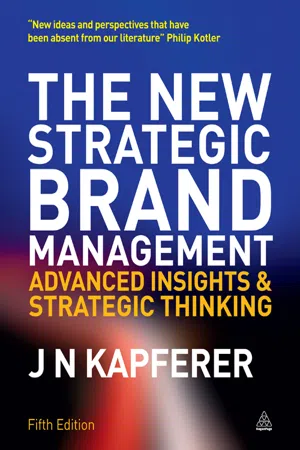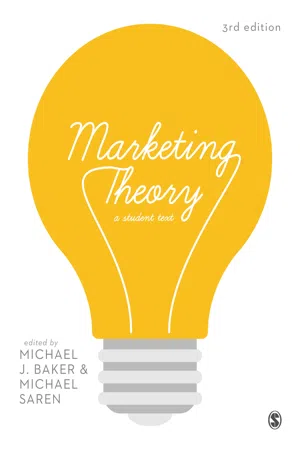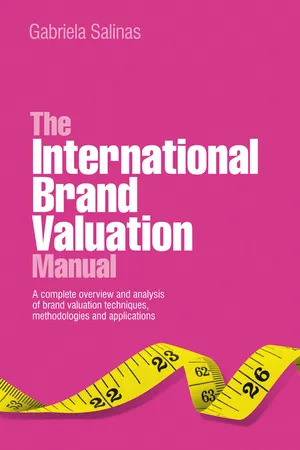Marketing
Brand value
Brand value refers to the perceived worth of a brand in the eyes of consumers. It encompasses the intangible aspects of a brand, such as its reputation, customer loyalty, and overall market position. A strong brand value can lead to increased customer trust, higher sales, and a competitive advantage in the market.
Written by Perlego with AI-assistance
7 Key excerpts on "Brand value"
Learn about this page
Index pages curate the most relevant extracts from our library of academic textbooks. They’ve been created using an in-house natural language model (NLM), each adding context and meaning to key research topics.
- Su Mi Dahlgaard-Park(Author)
- 2015(Publication Date)
- SAGE Publications, Inc(Publisher)
Brand value Brand value42 44Brand value
Brand value is what a brand is worth to management and shareholders. Managerstend to estimate the value of every asset, whether it is tangible orintangible. Tangible assets are often easy to estimate, while intangibleassets, such as brands, are more difficult to value. The most commonly usedvaluation models for brand are discounted cash flows, book-to-market, grossprofit differential, and relief from royalty. All these methods considerfuture economic benefit of brand ownership, discounted for market andbrand-specific risks.Another concept intricately linked with Brand value is brand equity. Brandequity is a phrase used in the marketing industry that describes thesubjective value of a brand name in the customers’ minds. Specifically,brand equity is the incremental utility with which a brand endows a product.In the beginning, brand names may be seen only as names or symbols, butafter customers start to experience the products, the brand will incorporatecustomer experience and expectations vis-à-vis a company’s promises.Accordingly, a brand name is a name that contains value (brand equity),rather than just a name. Brand equity is the value endowed by the brand nameto the product, such that consumers are willing to pay a premium price forproducts with the particular brand name.Positive brand equity occurs when the consumer is familiar with the brand andholds some favorable, strong, and unique brand associations in memory. Ifconsumers perceive a particular brand favorably, they are more likely tochoose, and pay a premium price for, products associated with thatparticular brand name. This outcome can produce tremendous competitiveadvantages for any company.Researchers propose that brand equity can create value for the company aswell as for the customer. From the customers’ perspective, they can usebrand to speed the purchasing process and to decrease purchasing risksbecause a familiar brand can be perceived to be reliable and of reasonablequality. Customers can also get additional emotional value from brandingattributes (e.g., social status). From a company’s point of view, strongbrand equity can increase company revenue, generate higher customer loyalty,and decrease vulnerability to competitive marketing campaigns. Research shows that ahigh level of brand equity can lead to high consumer preferences andpurchase intentions.- eBook - ePub
The New Strategic Brand Management
Advanced Insights and Strategic Thinking
- Jean-Noël Kapferer(Author)
- 2012(Publication Date)
- Kogan Page(Publisher)
Table 1.2 , the arrows indicate not a direct but a conditional consequence. The same brand assets may produce different brand strength over time: this is a result of the amount of competitive or distributive pressure. The same assets can also have no value at all by this definition, if no business will ever succeed in making them deliver profits, through establishing a sufficient market share and price premium. For instance if the cost of marketing to sustain this market share and price premium is too high and leaves no residual profit, the brand has no value. Thus the Virgin name proved of little value in the cola business: despite the assets of this brand, the Virgin organization did not succeed in establishing a durable and profitable business through selling Virgin Cola in the many countries where this was tried. The Mini was never profitable until the brand was bought and manufactured by BMW, then relaunched as Mini.Table 1.2 also shows an underlying time dimension behind these three concepts of assets, strength and value. Brand assets are learnt mental associations and affects. They are acquired through time, from direct or vicarious, material or symbolic interactions with the brand. Brand strength is a measure of the present status of the brand: it is mostly behavioural (market share, leadership, loyalty, price premium). Not all of this brand stature is due to the brand assets. Some brands establish a leading market share without any noticeable brand awareness: their price is the primary driver of preference. There are also brands whose assets are superior to their market strength: that is, they have an image that is far stronger than their position in the market (this is the case with Michelin, for example). The obverse can also be true, for example of many retailer own brands, which are ‘push’ brands.Brand value is a projection into the future. Brand financial valuation aims to measure the brand’s worth, that is to say, the profits it will create in the future. To have value, brands must produce economic value added (EVA), and part of this EVA must be attributable to the brand itself, and not to other intangibles (such as patents, know-how or databases). This will depend very much on the ability of the business model to face the future. For instance, Nokia lost ground on the Stock Exchange in 2010. The market had judged that the future of the world’s number one mobile phone brand was dim. Everywhere in the developed countries, consumers are buying smartphones, but Nokia is lagging. Nokia’s present brand stature might be high, but what about its value? - eBook - ePub
Brand Transformation
Transforming Firm Performance by Disruptive, Pragmatic and Achievable Brand Strategy
- Keith Glanfield(Author)
- 2018(Publication Date)
- Routledge(Publisher)
Measuring “Brand value” is very different from “brand valuation.” Brand value quantifies, in financial terms, the market influence of a firm’s brand set over a time period. It financially quantifies brand cause and effect and is a useful exercise to undertake. It provides a financial number that calculates the “value” branding brings to a firm. An example is the Interbrand list of top 100 world leading brands. It ranks the “value” of the world’s leading 100 brands (Apple, McDonalds, KFC, IBM, etc.). Those that generate a large number are considered to be more leading and powerful than those with a smaller number. For major world leading brands, no doubt a firm’s position in the rankings, or even appearing on the list of top 100 brands, is regarded as a form of prestige and one of a number of sources used for investor relations and corporate public relations purposes. For much smaller firms, this information is “nice to have” and important in establishing a business case and justification for a firm to appropriately invest in branding. Again what is important in day-to-day management terms are the factors that influence the “value” branding brings to a firm. Central to this is branding’s influence on consumers and what elements positively influence customer choice and loyalty. To measure and assess this, firms and their marketers need to turn to brand strength, or what is commonly termed “brand equity.”Brand equity is the quantification and measurement of a brand’s overall strength. It measures the influence of brands with consumers. Brand equity does not put a financial value against a brand but instead determines, from a consumer point of view, what aspects of a brand work well and not so well. A number of alternative perspectives are taken to measuring brand equity. They range from measuring a brand’s incremental influence on consumer’s response to marketing communications activity on to assessing the incremental contribution branding makes to consumer preference for a given product or service. In broad terms, brand equity comprises brand loyalty, perceived quality, brand awareness and brand associations, measuring the influence of each on consumer brand preference. Understanding the market and consumer influence of branding, relative to a firm’s competitors, is extremely important for a firm to measure and understand. It is the foundation of “brand valuation” and “Brand value” and forms the essential set of measures a firm needs to develop to fundamentally understand the performance of its brands.In summary, “brand valuation” puts a valuation to brands as an intangible asset. This is more of a concern for finance professionals than marketers and is not, therefore, considered to be of further relevance in this book (see ISO 10668 for more information). However, “Brand value” and “brand equity” are both of interest to marketers and firms alike. The former establishes the financial contribution branding delivers to a firm. The latter is a measure of branding performance from a consumer perspective. Both potentially drive important outcomes for a firm and its investors, including margin or net profit (earnings before interest and taxation), cash flow and dividend yields. It is, therefore, important to understand the composition of each and their relative influence on a firm’s performance. - eBook - ePub
Aaker on Branding
20 Principles That Drive Success
- David Aaker(Author)
- 2014(Publication Date)
- Morgan James Publishing(Publisher)
It is hard to overemphasize the importance of the brand-as-asset concept. In the history of marketing there are a few concepts that have truly transformed the practice of marketing. Mass marketing, the marketing concept, and segmentation would surely be named. But the “brand as asset” view of brands and brand building, although not always easy to implement, needs to be on the list as well.Passage contains an image Chapter 2 BRAND ASSETS HAVE REAL VALUE
Brand value is very much like an onion. It has layers and a core.The core is the user who will stick with you until the very end.—Edwin Artzt, former CEO P&GB rand assets have real value. This assertion is critical to living in the new brand-as-asset world, with all its implications, from business strategy to marketing programs to the resourcing and management of brand building. But as branding becomes strategic and earns a seat at the executive table, the CEOs and CFOs of the world, who may have sympathy with the brand asset concept, will ultimately need proof that value actually exists. A conceptual argument will be part of the persuasion, but more empirical evidence may be necessary as well.Investments in brand were easy to justify under the classic brand management paradigm, which focused on short-term sales. Brand programs either delivered immediate sales and profits or they did not. Building brand assets, however, may involve consistent reinforcement over years and only a small portion of the pay-off may occur immediately—in fact, in the short run brand building may depress profits. So the need is to measure long-term brand impacts or its surrogates. We have left the tactical world, in which short-term measures work.There are a variety of ways that brand asset value can be demonstrated, including case studies, brand valuations, quantitative studies of the impact of brand equity, and the role of brand assets in conceptual business strategy models.CASE STUDIESA vivid, convincing, and memorable way to demonstrate brand asset value is to look at case studies. Look to brands that have undeniably contributed to the creation of enormous value. The Apple brand, for example, with its creative, independent personality and reputation for being a leading innovator, is a driver of one of the most valuable firms in the world. BMW has gotten traction in large part because of a brand defined around the “ultimate driving machine” and the self-expressive benefits that the badge lends to the driver. Trader Joe’s has dominated a subcategory with a brand that has crystalized a set of values and life-style that delivers both self-expressive and social benefits. - eBook - ePub
Marketing Theory
A Student Text
- Michael J Baker, Michael Saren(Authors)
- 2016(Publication Date)
- SAGE Publications Ltd(Publisher)
The concept of brand equity emerged in marketing in the 1980s. Advertising practitioners in the USA used the concept to counter stockmarket emphasis on short-term results and consequent cuts to brand advertising budgets. In order to convince senior managers of the long-term value of brand advertising and other marketing investments, it was argued that marketing needed financial measures of Brand value. Thus the term ‘brand equity’ was coined to refer to the brand’s long-term customer franchise which also had a financial value. The marketing community has also used the term equity to refer to the asset value of other marketing investments. Rust et al. (2000) and Blattberg et al. (2001) use the term ‘customer equity’ to focus on the financial value of customers to an organization, while Anderson et al. (2009) use the term ‘marketplace equity’ to represent the joint result of investments in brand equity, channel equity and reseller equity. In measuring that customer franchise, what became apparent was the lack of a clear and consistent conceptual framework for brand equity. While marketing academics had devoted considerable attention to understanding the nature of brand equity, less attention had been given to the financial consequences of activities designed to increase brand equity. Thus the financial costs as indicated by a brand’s advertising budget used to build a brand can be measured but not the outcome of such a cost. Furthermore, many practitioners often refer to brand marketing costs as an ‘investment’ in brand building. Thus attention is needed to focus on measuring the outcomes of brand building.As a market-based asset, brands need to meet several criteria to be considered as a firm resource of value to the company (Kozlenkova et al., 2014). These criteria include the difficulty of imitation and the extent to which the brand resources may be leveraged to achieve a greater return on investment. The intangibility of brand assets is reflected in the difficulty of imitation as brands have a distinct identity which can be built over the long-term. The brand resource may also be leveraged or extended to complement other firm resources thus creating additional benefits for the firm. For example, a brand can be extended into new product categories for the firm creating additional revenue. In this sense the brand resource is complementary to both the other tangible and intangible assets within the firm.Aaker (1996: 7) defines brand equity as ‘the assets and liabilities linked to a brand, its name and symbol, that add to or subtract from the value provided by a product or service to a firm and/or to that firm’s customers’. This asset/liability perspective leads to a broader view about the role of the brand. The Aaker perspective recognizes that the value of brand equity consists of both positive and negative aspects (assets and liabilities) of the brand. Furthermore, these assets and liabilities can enhance or reduce revenues for the firm. The value of a strong brand can be seen when comparing the sales of a national brand with the sales of weaker competitors’ brands in the same category or even comparing to sales of a retailer’s private label brand (Apelbaum et al., 2003). In addition, brand equity has benefits for the marketer beyond sales revenue performance. Brand equity can improve advertising efficiency, enhance customer loyalty, lead to extension opportunities and create brand licensing opportunities in the future.The chapter proceeds as follows. First the use of the term equity in branding is considered. The next section - eBook - ePub
The International Brand Valuation Manual
A complete overview and analysis of brand valuation techniques, methodologies and applications
- Gabriela Salinas(Author)
- 2011(Publication Date)
- Wiley(Publisher)
These models boost our understanding of brand strengths and weaknesses in competitive environments, and enhance our insight into the development of consumer perception. In general, although they serve as good tools for brand evaluation per se, they are not useful for estimating a brand’s economic value. Still, they can be constructive resources for valuers and useful in understanding a brand’s potential in the relevant market.1.2.2 How Do Brands Create Value?In economic terms, brands create value by affecting both supply and demand curves. On the demand side , they allow a product to be sold at a higher price, given a determined sales volume. Strong brands can also increase their sales volume and decrease their customer defection rate. In a complex and saturated market, brands play a fundamental role in consumer choice by introducing functional and emotional attributes. Therefore, they allow the firm to reach a more stable demand level. This brings obvious economic benefits, given that the cost of acquiring new customers is 10 or 20 times greater than that of retaining current customers. Strong brands are also capable of transferring values associated with the brand to new categories of products or services.On the supply side, brands may reduce operating costs by increasing distributors’ loyalty, improving personnel recruiting and retention costs, capital financial costs, and finally, by increasing economies of scale through greater volumes.1.3 The Growing Importance of the Economic Value of BrandIntangible assets and brands are the objects of increasing attention in five rather different fields (see Figure 1.5 ).1.3.1 Business EvidenceFigure 1.5 Evidence of the growing importance of intangible assets and brands.Source: Developed by authorNumerous initiatives, forums and institutions promoted by large business corporations demonstrate the increasing concern for the valuation and reporting of intangibles in the business world. The following are some such initiatives: - eBook - ePub
Global Brand Management
A Guide to Developing, Building & Managing an International Brand
- Laurence Minsky, Ilan Geva(Authors)
- 2019(Publication Date)
- Kogan Page(Publisher)
Of course, there are other disciplines that contribute to our understanding of the power of branding, the practices of brand management and the need to adjust brand elements (the study of semiotics, for instance, comes to mind), but these are some of the core disciplines. And while we can only give a brief overview here, we encourage you to dig deeper into them, for they inform our approach, as you will see throughout the rest of this book.There is one other question that we must address before proceeding to the core of managing a global brand and that is ‘What is the value of branding and how do we determine it?’ While we assume that you wouldn’t be reading this book – and we wouldn’t have written it – without assuming that branding creates value, it is always better to be armed with the evidence.Determining the value of the brand
We address this topic, because many still even question when a brand becomes a brand. Some believe that critical mass is a qualifying measure. If so, what is the minimal size of a faithful audience that a brand needs? What is the financial threshold that a product or service must cross to become a ‘brand’?At the end of the day, since brands are intangible assets, we need some ways to measure their value. After all, many branding professionals preach the importance of building brands by emphasizing the actual monetary value to the owner. In fact, the term ‘brand equity’ could simply be defined as ‘the value that comes from the consumers’ perception of the brand (product or service), and not just from the product or service itself.’Since we know that the consumer is now in the driver’s seat when it comes to deciding the fate of brands, brand equity is also in the hands of consumers. Tracking brand equity is different in many markets. Companies such as Nielsen are using their proprietary methods to measure brand equity with market share and customer loyalty. Other similar organizations are using slightly different methodologies or technology to assess pretty much the same things: brand strength; brand image; brand behaviour; and key performance indicators.So how do we begin to calculate the actual value? There is no ‘right way’ and the answer is never complete. After all, if we only measure a brand by looking at the sales, how confident are we that the sales are generated only because of the brand image? Could it not be the actual product attributes? Or the amazing customer service?






